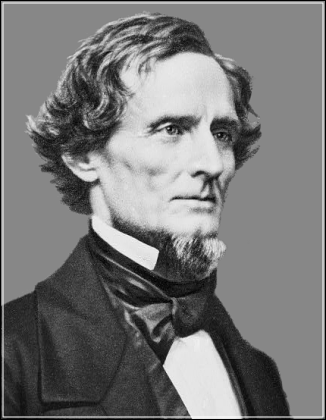


Jefferson Davis (1808-1889)Jefferson Davis was born in a log cabin in Kentucky, the youngest and tenth child of Samuel and Jane Davis. His birthplace was less than 100 miles from that of Abraham Lincoln (also a log cabin in Kentucky) and the two were born within one year of each other. Davis’ father had served in the Continental Army during the American Revolutionary War. His father took up tobacco planting but the family never became very wealthy. At one time they moved to Woodville, Mississippi. Davis received much of his early academic education at home in Kentucky and Mississippi. However, from age 7 to 9 he attended St. Thomas School in Kentucky (the only Protestant student in the Catholic school), and from age 13 to 16 he went to Transylvania University (in those days kind of like a college prep school), where he received a classical education. Davis was interested in studying law just like Abraham Lincoln, but his family convinced him to pursue military training instead. In 1824, Davis was appointed by President Monroe to West Point military academy as a cadet, and he graduated as an officer of the army in 1828. Davis was said to possess great intelligence and imagination although he was reserved and severe in manner, indecisive and stubborn. He was also described as having a "slight, light figure, little exceeding middle height, and holds himself erect and straight." He had high, prominent cheek bones, thin lips, and deep-set eyes. After graduating from West Point, Davis served in the Black Hawk War in 1832, where Abraham Lincoln also served. Davis fell in love with the daughter of his commanding officer, Colonel Zachary Taylor, who would later be president of the United States. Sarah Taylor’s father did not approve of the match, but Davis resigned from the army in 1835 and married her anyway. Taylor was at first furious, but he eventually reconciled and even became friendly with Davis. Their marriage ended in tragedy, however, when Sarah died three months later of malaria which she caught in Louisiana while visiting her sister. Davis returned to Mississippi as a planter and stayed there for the next ten years. Davis tended to his plantation, read extensively, and made only infrequent excursions outside his community. In 1844, Davis married Varina Anne Howell, the daughter of a wealthy Mississippi planter. That same year he was elected to the U.S. House of Representatives, where he became a leading spokesman for state’s rights. One year later, Davis joined General Zachary Taylor in the Mexican War as commander of a Mississippi regiment. He returned a war hero, and was soon appointed to the Senate. In 1853 he became secretary of war under President Franklin Pierce, where he demonstrated his southern expansionist leanings and defense of slavery. Davis exhibited a strong interest in opening up the West, securing funding for surveys of wagon roads and railroads. He also proposed the use of camels by the army in the Southwest. To carry out the task, Davis picked Edward Fitzgerald Beale, a lieutenant in the Topographical Engineers. Beale acquired 30 camels from the Middle East, which arrived in Texas in 1856. Beale was successful in opening up the wagon route, however, the project was abandoned when the Civil War arrived. When the southern states seceded from the Union and formed the Confederacy, the southern leaders chose Jefferson Davis as their president. In 1862 he was inaugurated at Richmond, Virginia, the only president of the short-lived Confederate States of America. President Lincoln allowed a journalist and a minister through Union lines in July 1864 under a flag of truce to offer peace and amnesty to Davis, but the Confederate president was outraged. “Amnesty, Sir, applies to criminals," he told the envoys. "We have committed no crime. At your door lies all the misery and crime of this war ... We are fighting for Independence — and that, or extermination, we will have ... You may emancipate every Negro in the Confederacy, but we will be free. We will govern ourselves ... if we have to see every Southern plantation sacked, and every Southern city in flames.” At the end of the Civil War in 1865, Davis was taken into custody in Georgia. He was held at Fort Monroe, while the government tried him as a war criminal and charged him with treason. The case dragged on for years, but was dropped in 1869 after President Johnson issued his proclamation of unconditional amnesty, restoring constitutional rights to all who had supported the Confederacy. After the trial ended and Davis was released, he returned to Mississippi where he wrote The Rise and Fall of the Confederate Government. He and his second wife had six children, but three died tragically at a young age. Margaret was the only Davis child to lead a long life and marry. In the early 20th century, the United Daughters of the Confederacy lobbied for a southern coast-to-coast highway to honor the Confederate president, like the Lincoln Highway in the north. The UDC planned the highway to start in Washington, D.C. and travel through the southern states until its terminus at San Diego, but their idea never really caught on. However, State Route 80 between Bisbee and Benson (running north and south of Tombstone) is called the Jefferson Davis Memorial Highway. At the time of the Civil War, many towns in southern Arizona had confederate leanings. The Davis Family Association holds its annual reunion May 31 through June 1 at the Rosemont Plantation, Davis' childhood home in Woodville, Mississippi. The Davis family thinks it's a shame that all most people know about him was that he fought to preserve slavery, said Davis’ great-great grandson, Bertram Hayes-Davis. "The Civil War is the central event in our nation’s history, and Davis had a critical part to play in that," explains William J. Cooper, a professor of history at Louisiana State University and author of Jefferson Davis, American. "And not to study it makes no sense to me." References www.civilwarhome.com/jdavisbio.htm (Jefferson Davis biography.) www.ssrc.msstate.edu/grr/wilkhm.html (Photo of Jefferson Davis historical marker that states: “Jefferson Davis’ boyhood home. Built 1810, by father, Samuel Davis. First schooling in log cabin here.”) http://histclo.com/pres/ind19/davis.html (Jefferson Davis facts and sources.) www.veteranstoday.com/modules.php?name=News&file=article&sid=2879 (200th Birthday of U.S. War Veteran Jefferson Davis.)
Contact: . Thanks! Please click here for reprint permission.


These pages are a continuous work in progress.
|
Help Support this Site
and purchase items via our affiliate links. Thank you!
 
Thank you for visiting my |

